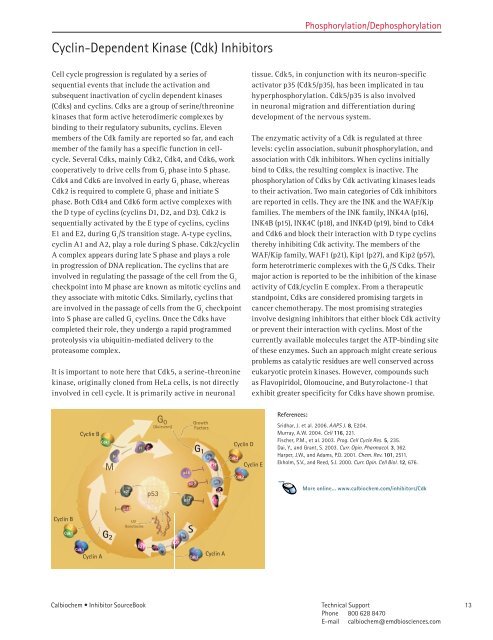Inhibitor SourceBook™ Second Edition
Inhibitor SourceBook™ Second Edition
Inhibitor SourceBook™ Second Edition
Create successful ePaper yourself
Turn your PDF publications into a flip-book with our unique Google optimized e-Paper software.
Cyclin-Dependent Kinase (Cdk) <strong>Inhibitor</strong>s<br />
Cell cycle progression is regulated by a series of<br />
sequential events that include the activation and<br />
subsequent inactivation of cyclin dependent kinases<br />
(Cdks) and cyclins. Cdks are a group of serine/threonine<br />
kinases that form active heterodimeric complexes by<br />
binding to their regulatory subunits, cyclins. Eleven<br />
members of the Cdk family are reported so far, and each<br />
member of the family has a specific function in cellcycle.<br />
Several Cdks, mainly Cdk2, Cdk4, and Cdk6, work<br />
cooperatively to drive cells from G 1 phase into S phase.<br />
Cdk4 and Cdk6 are involved in early G 1 phase, whereas<br />
Cdk2 is required to complete G 1 phase and initiate S<br />
phase. Both Cdk4 and Cdk6 form active complexes with<br />
the D type of cyclins (cyclins D1, D2, and D3). Cdk2 is<br />
sequentially activated by the E type of cyclins, cyclins<br />
E1 and E2, during G 1 /S transition stage. A-type cyclins,<br />
cyclin A1 and A2, play a role during S phase. Cdk2/cyclin<br />
A complex appears during late S phase and plays a role<br />
in progression of DNA replication. The cyclins that are<br />
involved in regulating the passage of the cell from the G 2<br />
checkpoint into M phase are known as mitotic cyclins and<br />
they associate with mitotic Cdks. Similarly, cyclins that<br />
are involved in the passage of cells from the G 1 checkpoint<br />
into S phase are called G 1 cyclins. Once the Cdks have<br />
completed their role, they undergo a rapid programmed<br />
proteolysis via ubiquitin-mediated delivery to the<br />
proteasome complex.<br />
It is important to note here that Cdk5, a serine-threonine<br />
kinase, originally cloned from HeLa cells, is not directly<br />
involved in cell cycle. It is primarily active in neuronal<br />
Cyclin B<br />
Cdk1<br />
Cdk1<br />
Cyclin B<br />
Cyclin A<br />
Cdk1<br />
Calbiochem • <strong>Inhibitor</strong> SourceBook<br />
H<br />
E2F<br />
E2F<br />
Cdk2<br />
E2F<br />
Cyclin A<br />
Cdk4<br />
Cyclin D<br />
Cdk2<br />
Phosphorylation/Dephosphorylation<br />
tissue. Cdk5, in conjunction with its neuron-specific<br />
activator p35 (Cdk5/p35), has been implicated in tau<br />
hyperphosphorylation. Cdk5/p35 is also involved<br />
in neuronal migration and differentiation during<br />
development of the nervous system.<br />
The enzymatic activity of a Cdk is regulated at three<br />
levels: cyclin association, subunit phosphorylation, and<br />
association with Cdk inhibitors. When cyclins initially<br />
bind to Cdks, the resulting complex is inactive. The<br />
phosphorylation of Cdks by Cdk activating kinases leads<br />
to their activation. Two main categories of Cdk inhibitors<br />
are reported in cells. They are the INK and the WAF/Kip<br />
families. The members of the INK family, INK4A (p16),<br />
INK4B (p15), INK4C (p18), and INK4D (p19), bind to Cdk4<br />
and Cdk6 and block their interaction with D type cyclins<br />
thereby inhibiting Cdk activity. The members of the<br />
WAF/Kip family, WAF1 (p21), Kip1 (p27), and Kip2 (p57),<br />
form heterotrimeric complexes with the G 1 /S Cdks. Their<br />
major action is reported to be the inhibition of the kinase<br />
activity of Cdk/cyclin E complex. From a therapeutic<br />
standpoint, Cdks are considered promising targets in<br />
cancer chemotherapy. The most promising strategies<br />
involve designing inhibitors that either block Cdk activity<br />
or prevent their interaction with cyclins. Most of the<br />
currently available molecules target the ATP-binding site<br />
of these enzymes. Such an approach might create serious<br />
problems as catalytic residues are well conserved across<br />
eukaryotic protein kinases. However, compounds such<br />
as Flavopiridol, Olomoucine, and Butyrolactone-1 that<br />
exhibit greater specificity for Cdks have shown promise.<br />
Cyclin E<br />
References:<br />
Sridhar, J. et al. 2006. AAPS J. 8, E204.<br />
Murray, A.W. 2004. Cell 116, 22 .<br />
Fischer, P.M., et al. 2003. Prog. Cell Cycle Res. 5, 235.<br />
Dai, Y., and Grant, S. 2003. Curr. Opin. Pharmacol. 3, 362.<br />
Harper, J.W., and Adams, P.D. 200 . Chem. Rev. 101, 25 .<br />
Ekholm, S.V., and Reed, S.I. 2000. Curr. Opin. Cell Biol. 12, 676.<br />
More online... www.calbiochem.com/inhibitors/Cdk<br />
Technical Support<br />
Phone 800 628 8470<br />
E-mail calbiochem@emdbiosciences.com<br />
3



